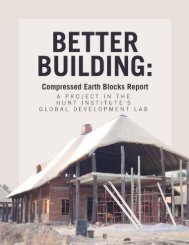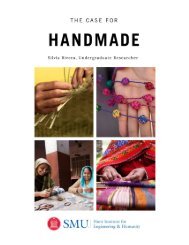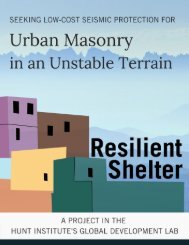Assessment of Rwanda Refugee Camps in the Context of the Villagization Process
Undergraduate researcher for the Hunt Institute for Engineering and Humanity and Engaged Learning Fellow Sienna Dugan, researched secondary sources and primary research through site visits, participatory observation, and interviews with key informants to compile this report which is structured like a case study with additional literature review. All photography is original to the student from her in-field research.
Undergraduate researcher for the Hunt Institute for Engineering and Humanity and Engaged Learning Fellow Sienna Dugan, researched secondary sources and primary research through site visits, participatory observation, and interviews with key informants to compile this report which is structured like a case study with additional literature review. All photography is original to the student from her in-field research.
You also want an ePaper? Increase the reach of your titles
YUMPU automatically turns print PDFs into web optimized ePapers that Google loves.
4.0 Discussion
The purpose of this study was to evaluate the current needs through a general analysis of
Mahama refugee camp, analyze how UNHCR was responding to such needs through CRRF, and
lastly look at other case studies of villagization processes in nearby countries to select best
practices. After analysis of the current status of Mahama Camp the most urgent issues are
overcrowded living conditions; poor environmental sanitation, inadequate shelter and poor
nutritional status. These issues consequentially result in an increased transmission of infectious diseases
and lowered immunity.
Attention must be focused on correcting, maintaining, and building
infrastructure and wash facilities. Most specifically, measures to combat the effects of erosion and
overcrowding must be implemented. This is most often done by planting trees and grass or
building further drainage pathways. Poor drainage systems, gullies and landslides currently occur
across all six camps and lead to an increase in accidental injuries. The lack of available and proper
living services and limited land has led to overcrowding and homelessness which results in
increased rates of sexual violence. With families of 12 living sharing houses built for 6,
transmission rates of diseases have increased. Inadequate budgets and increasing populations have
led to and continue to lead to increasing poverty levels which result in growing numbers of school
dropouts. The number of cascading events is endless without proper living amenities.
Traditionally built to offer protection for those seeking refuge, the design of refugee camps
focuses on ease of distributing humanitarian relief until a durable solution can be found. Although
initially practical, this approach is not conducive to protracted displacement and often results in
refugee’s reliance on humanitarian aid. With protracted displacement, solutions that were once
durable deteriorate and new hardships arise often creating situations that mimic those refugees
28













